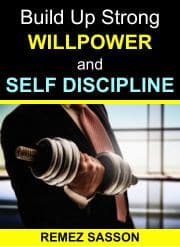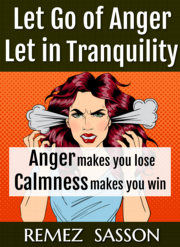
Feeling angry is a natural human emotion, and it’s perfectly normal to experience anger from time to time. However, when anger becomes uncontrollable and starts to affect your daily life, it’s time to take action.
Finding ways to release anger and find inner peace is crucial to maintaining your mental and emotional well-being.
This article explores several strategies that can help you manage your anger and find inner peace. These strategies are easy to implement, and are effective for overcoming anger issues.
Browse our online courses on meditation, positive thinking, overcoming procrastination, confidence, and freedom from distractions.
Whether you are dealing with anger in the workplace, at home, or in your personal life, these tips will help you find the balance and inner peace that you need to live a happier and healthier life.
Let’s dive in and explore these strategies to release anger and find inner peace.
Understanding Anger and Its Effects on the Mind and Body
Before we dive into the strategies for releasing anger, it’s important to understand what anger is and how it affects the mind and body.
Anger is a natural response to a perceived threat or injustice, and it can be triggered by a range of situations and stimuli.
When we feel angry, our bodies release a surge of hormones, including adrenaline and cortisol, which prepare us for the “fight or flight” response.
This surge of hormones can cause physical symptoms such as increased heart rate, rapid breathing, and tensed muscles.
While anger is a normal emotion, it can become problematic when it is expressed in unhealthy or destructive ways.
Chronic anger can lead to a range of negative physical and mental health effects, including high blood pressure, heart disease, anxiety, and depression.
Therefore, it’s important to find healthy ways to release anger and manage the associated stress and tension.
The Importance of Releasing Anger for Mental and Physical Health
Releasing anger is crucial to maintaining good mental and physical health. When we hold onto anger, it can fester and grow, leading to chronic stress and tension.
This can lead to physical symptoms, such as headaches, muscle tension, and digestive issues. It can also have a negative impact on our mental health, leading to increased anxiety, depression, and difficulty sleeping.
By finding healthy ways to release anger, we can reduce stress and tension in the body, improve our mental and emotional well-being, and enhance our overall quality of life.
The strategies we will explore in this article are designed to help you release anger in healthy and productive ways, so that you can find inner peace and live a happier and healthier life.
Related: Anger quotes.
Strategy 1: Mindful Breathing and Meditation
One of the most effective ways to release anger and find inner peace is through mindful breathing and meditation.
Mindful breathing involves focusing your attention on your breath, and noticing the sensations of breathing as you inhale and exhale.
Meditation involves sitting quietly and focusing your attention on a single point of focus, such as your breath, a mantra, or a visualization.
Research has shown that regular mindful breathing and meditation can help reduce symptoms of anxiety, depression, and stress, and can also help improve overall well-being.
When we practice mindful breathing and meditation, we learn to observe our thoughts and feelings without judgment, allowing us to develop greater self-awareness and emotional regulation.
To get started with mindful breathing and meditation, find a quiet place where you won’t be disturbed. Sit comfortably with your eyes closed.
Begin by taking a few deep breaths, while shifting your attention to your breath.
Notice the sensation of the air as it enters and leaves your body, and try to focus your attention on your breath for a few minutes. If your mind wanders, gently redirect your attention back to your breath.
Over time, you can increase the duration of your meditation practice, and incorporate other mindfulness techniques into your daily routine.
Strategy 2: Physical Exercise and Movement
Another effective way to release anger and find inner peace is through physical exercise and movement.
Exercise has been shown to have numerous mental and physical health benefits, including reducing stress, improving mood, and boosting self-esteem.
When we exercise, our bodies release endorphins, which are natural mood boosters that can help reduce feelings of anger and frustration.
To reap the benefits of exercise, it is important to find an activity that you enjoy and that fits into your lifestyle. This could be anything from running, swimming, or cycling, to yoga, weightlifting, or dancing.
In addition to formal exercise, incorporating movement into your daily routine can also be helpful for releasing anger.
This could include taking a walk around the block, stretching, or doing some simple yoga poses. The key is to find ways to move your body that feel good and help you release tension and stress.
Strategy 3: Creative Expression and Art Therapy
Another effective way to release anger and find inner peace is through creative expression and art therapy. Engaging in creative activities such as painting, drawing, or writing can help us express and process our emotions in a healthy way.
It is said that art therapy can be particularly effective for reducing symptoms of anxiety, depression, and stress, and can help improve overall well-being.
The act of creating art can be therapeutic in itself, and can also help us gain insight into our emotions and thought patterns.
To get started with creative expression and art therapy, set aside some time each day to engage in a creative activity that you enjoy. This could be as simple as drawing in a sketchbook, painting, or coloring in a coloring book.
The key is to find an activity that feels enjoyable and helps you release tension and stress.
Strategy 4: Communication and Conflict Resolution Skills
Another important aspect of releasing anger and finding inner peace is developing strong communication and conflict resolution skills.
Often, anger is triggered by interpersonal conflicts or misunderstandings. Learning how to communicate effectively can help resolve these conflicts in a healthy way.
Effective communication involves listening actively, expressing yourself clearly, and being empathetic and open-minded.
When we communicate effectively, we can avoid misunderstandings and conflicts, and can build stronger relationships with those around us.
Practice active listening and expressing yourself clearly and calmly, and be open to feedback from others.
Strategy 5: Seeking Professional Help and Therapy
Finally, if you are struggling with chronic anger or find that your anger is impacting your daily life, seeking professional help and therapy can be an effective way to release anger and find inner peace.
A therapist or counselor can help you identify the underlying causes of your anger, and can provide you with tools and strategies for managing your emotions in a healthy way.
Therapy can also provide you with a safe and supportive space to explore your emotions and work through any underlying issues that may be contributing to your anger.
Whether you choose individual therapy or group therapy, seeking professional help can be a powerful step towards finding inner peace and emotional well-being.
Combining Strategies for Maximum Effectiveness
While each of these strategies can be effective on their own, combining them can be even more powerful.
For example, you could start your day with a few minutes of mindful breathing, followed by a yoga or exercise session.
You could then spend some time engaging in a creative activity, such as painting or writing, before practicing your communication and conflict resolution skills.
By incorporating multiple strategies into your daily routine, you can create a holistic approach to managing anger and finding inner peace.
Experiment with different strategies and find the combination that works best for you.
Finally, it is important to remember that finding inner peace is an ongoing process that requires consistent effort and practice. It is not something that can be achieved overnight, but rather a journey that requires patience, self-compassion, and perseverance.
To maintain your inner peace in the long term, make self-care a priority in your daily routine. This could include getting enough sleep, eating a healthy diet, and engaging in regular exercise or movement.
It could also involve practicing mindfulness or meditation, engaging in creative activities, and seeking the support of friends, family, or a therapist.
Remember, finding inner peace is a journey, not a destination. Be kind to yourself, and celebrate each small step that you take towards greater emotional well-being.
Conclusion
In conclusion, releasing anger and finding inner peace is crucial to maintaining good mental and physical health.
By incorporating the different strategies mentioned in this article, you teach yourself to become more relaxed and avoid anger.
Browse our online courses on meditation, positive thinking, overcoming procrastination, motivation, confidence, and freedom from distractions.



